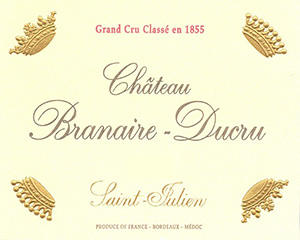| Region | |
|---|---|
| Subregion | France > Bordeaux > Left Bank > St Julien |
| Colour | Red |
| Type | Still |

Haut couture becomes a wine! This dense purple wine has the tell-tale notes of flowers and pencil shavings, and its broad aromatics are intense and totally captivating. Powerful, rich, and full, but less tannic than the 2005 and more opulent, this is a dazzling Branaire to drink between 2017-2035.
Gorgeous aromas of dark berries and wet earth, with hints of graphite. Full body, with juicy, chewy tannins and a long rich, fruity, and succulent finish. Best ever from here. Try in 2019.
The 2009 Branaire-Ducru has a medium to deep garnet color and reveals compelling notions of warm cassis, licorice, baked plums and hoisin with hints of sautéed herbs and pencil lead. Youthful and medium to full-bodied, it has a generous core of black fruits with a firm and grainy structure and bags of freshness, finishing long with great purity. 2020 - 2040
Savoury tobacco-leaf nose. Pretty stodgy. Very dense almost bitter tannins. This may not be Las Cases but it is certainly Las Cases style... Mouth-puckeringly dry tannins. A very long-term bet. Drink 2020 - 2035.
Deep purple red, fragrant and precisely expressed Cabernet cassis, lovely depth of natural ripeness, a finely textured wine, already elegant and will age well. Drink 2015-28.
Lots of black fruits with some bitter chocolate character give this plenty of appeal. However, it’s a seriously tannic wine that still needs time to fully resolve. Drink now with hearty food or hold. Wait until 2022. (Horizontal Tasting, London, 2019)
Only time will tell whether the 2009, another great effort from Branaire, will eclipse the 2005 and 2003. Certainly at 13.6% alcohol it is the most powerful Branaire ever made, and the final blend of 70% Cabernet Sauvignon, 22% Merlot, and the rest Cabernet Franc and Petit Verdot showcases what a great vintage 2009 is for Cabernet Sauvignon. An inky/blue/purple color is followed by raspberry, boysenberry, crushed rock, graphite, and floral notes, and an opaque, broad, dense, substantial, impressively structured wine without any hardness. It requires 4-5 years of cellaring, and should last four decades or more. (Tasted two times.) Drink 2014-2054.
Tasted at the Union de Grand Cru in London. The Branaire Ducru has a relatively showy, almost exotic bouquet with fine delineation but missing a little focus. The palate is medium-bodied with a mocha-tinged entry, fine tannins, showing more harmony than the nose with a refined, mocha-tinged finish. Fine. Tasted October 2011.
Tasted at the château and at the UGC. A blend of 65% Cabernet Sauvignon, some of the Merlot (28%) plots reached 14.8%, the overall alcohol is 13.55% and pH 3.53. The Petit Verdot (4%) had very high quality tannins with good finesse, and 3% from old Cabernet Franc. A bright garnet core. The nose is well defined, quite elegant, but perhaps showing a little tighter than other Saint Juliens. Blackberry, a touch of cedar, like at Ducru, just a faint scent of the Gironde estuary and then with time, just a faint hint of griottes. The palate is full-bodied, nice grippy tannins, a little edgier than Ducru, a touch my sharpness and the acidity is racier. Good structure, a touch more rigid at this stage but that will melt by the time of bottling. A saline touch towards the finish interwoven with a citric thread. Good length. This is a Saint Julien standing to attention on parade. Hopefully it will stand at ease by bottling. Tasted March 2010.
Aromas of blueberry, dried citrus fruit and currant. Full-bodied, with chewy tannins and a long, long finish. Structured and tannic, but sweet fruit behind.